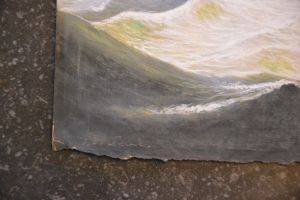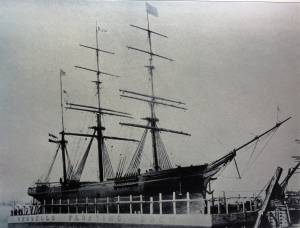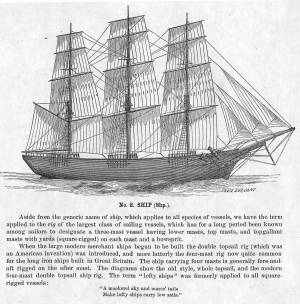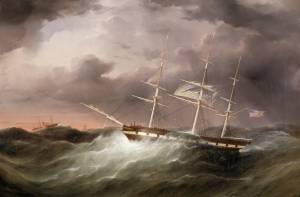An online project under the direction of the CAPE ANN MUSEUM
inv. 795
Three Master in Rough Seas (Watercolor)
c. 1856 Watercolor on paper 10 x 14 in. (25.4 x 35.6 cm) Signed lower left: F.H. Lane
Private collection
|
Related Work in the Catalog
Supplementary Images
Explore catalog entries by keywords view all keywords »
Historical Materials
Below is historical information related to the Lane work above. To see complete information on a subject on the Historical Materials page, click on the subject name (in bold and underlined).
See figs. 458 and 459.
"In taking in a Topsail, Fig. 458, the Weather Sheet (f), is first clewed up, because the Sail naturally flies to leeward, and keeps full: then the Bowline (e), and lee Sheet (d), being let go, the Sail catches aback, like Figure 459, and is taken almost without a Shake; for if the lee Sheet were eased off first, the Sail might shake so violently as to split. However it is sometimes necessary when a Vessel is weakly manned, to haul the Clew-line a little up, in order to get the weather Brace in."
Reference:
Lever, The Young Sea Officer's Sheet Anchor or a Key to the Leading of Rigging and Practical Seamanship, 2nd ed. (1819), 86.
The term "ship," as used by nineteenth-century merchants and seamen, referred to a large three-masted sailing vessel which was square-rigged on all three masts. (1) In that same period, sailing warships of the largest classes were also called ships, or more formally, ships of the line, their size qualifying them to engage the enemy in a line of battle. (2) In the second half of the nineteenth century, as sailing vessels were replaced by engine-powered vessels, the term ship was applied to any large vessel, regardless of propulsion or use. (3)
Ships were often further defined by their specialized uses or modifications, clipper ships and packet ships being the most noted examples. Built for speed, clipper ships were employed in carrying high-value or perishable goods over long distances. (4) Lane painted formal portraits of clipper ships for their owners, as well as generic examples for his port paintings. (5)
Packet ships were designed for carrying capacity which required some sacrifice in speed while still being able to make scheduled passages within a reasonable time frame between regular destinations. In the packet trade with European ports, mail, passengers, and bulk cargos such as cotton, textiles, and farm produce made the eastward passages. Mail, passengers (usually in much larger numbers), and finished wares were the usual cargos for return trips. (6) Lane depicted these vessels in portraits for their owners, and in his port scenes of Boston and New York Harbors.
Ships in specific trades were often identified by their cargos: salt ships which brought salt to Gloucester for curing dried fish; tea clippers in the China Trade; coffee ships in the West Indies and South American trades, and cotton ships bringing cotton to mills in New England or to European ports. Some trades were identified by the special destination of a ship’s regular voyages; hence Gloucester vessels in the trade with Surinam were identified as Surinam ships (or barks, or brigs, depending on their rigs). In Lane’s Gloucester Harbor scenes, there are likely (though not identifiable) examples of Surinam ships, but only the ship "California" in his depiction of the Burnham marine railway in Gloucester (see Three Master on the Gloucester Railways, 1857 (inv. 29)) is so identified. (7)
– Erik Ronnberg
References:
1. R[ichard)] H[enry] Dana, Jr., The Seaman’s Friend, 13th ed. (Boston: Thomas Groom & Co., 1873), p. 121 and Plate IV with captions.
2. A Naval Encyclopaedia (Philadelphia: L. R. Hamersly & Co., 1884), 739, 741.
3. M.H. Parry, et al., Aak to Zumbra: A Dictionary of the World’s Watercraft (Newport News, VA: The Mariners’ Museum, 2000), 536.
4. Howard I. Chapelle, The History of American Sailing Ships (New York: W.W. Norton & Co., 1935), 281–87.
5. Ibid.
6. Howard I. Chapelle, The National Watercraft Collection (Washington, DC: Smithsonian Institution, 1960), 26–30.
7. Alfred Mansfield Brooks, Gloucester Recollected: A Familiar History (Gloucester, MA: Peter Smith, 1974), 67–69.
Photograph
From American Clipper Ships 1833–1858, by Octavius T. Howe and Frederick C. Matthews, vol. 1 (Salem, MA: Marine Research Society, 1926).
Photo caption reads: "'Golden State' 1363 tons, built at New York, in 1852. From a photograph showing her in dock at Quebec in 1884."
Also filed under: "Golden State" (Clipper Ship) »
Oil on canvas
24 x 35 in.
Peabody Essex Museum, Salem, Mass.
Walters' painting depicts the "Nonantum" homeward bound for Boston from Liverpool in 1842. The paddle-steamer is one of the four Clyde-built Britannia-class vessels, of which one is visible crossing in the opposite direction.
View related Fitz Henry Lane catalog entries (2) »
Also filed under: Packet Shipping » // Walters, Samuel »
It was usual practice to prime all ship’s ironwork with red lead, which has a dark brownish red color. This was usually all that was done for anchors, but other ironwork, like chain plates. hawse pipe liners, chocks, cleats, and the iron on deck machinery was given a finish color, such as black, white, and sometimes bright red or other color. Ironwork in spars was also red-leaded, then painted to match the spar color—white, black, or brown if oiled or varnished bright. Lane’s work pre-dates galvanized hardware.



_sm.jpg)





Commentary
This work is a recent discovery as of 2022, a slightly smaller watercolor version of the dynamic small oil, Three Master in Rough Seas, 1856 (inv. 4), in the collection of the Cape Ann Museum. This painting was acquired at an auction in Belgium as an unknown work. Gallery labels on the back show that it was sold through the Max Bine Gallery in Paris which was active from 1914–1930. Lane did very few watercolors; we have not seen him use the medium as preparatory works for oils where one would expect a looser technique as he worked out ideas. The brushwork here is very precise and he doesn’t use washes or scumbles as is typical in preparatory works. He appears to be copying his oil original as the composition and details precisely follow the oil painting.
The original oil went directly from Lane’s studio to the Stacy family in Gloucester where it descended until given to the Cape Ann Scientific, Literary and Historical Association in 1948. This watercolor version is unrecorded—perhaps Lane did it for a friend as all his commissions we know of were for oil paintings, as was typical of the time. The paper is a fairly smooth, off-white paper, not a heavy or wove paper as one would expect for a watercolor commission. It is painted right to the edges of the paper, again atypical of a commission, where a border would be expected as Lane used in the watercolor Shooting Seabirds, c.1842 (inv. 789). How it got to Paris in the early 1900s remains a mystery.
– Sam Holdsworth
[+] See More